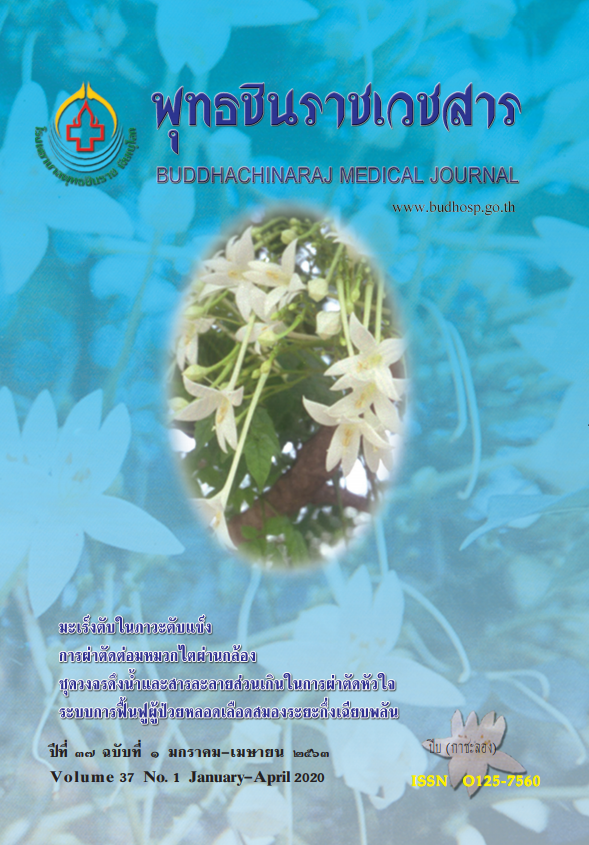ความรุนแรงในที่ทำงานต่อความเครียดและคุณภาพชีวิต ของบุคลากรโรงพยาบาลตติยภูมิ
ความรุนแรงในที่ทำงานของบุคลากรโรงพยาบาล
คำสำคัญ:
ความรุนแรงในสถานที่ทำงาน, ความเครียด, คุณภาพชีวิต, บุคลากรทางการแพทย์บทคัดย่อ
ความรุนแรงในสถานพยาบาลถือเป็นปัจจัยเสี่ยงจากการประกอบอาชีพที่พบได้ในบุคลากรทางการแพทย์ปัจจุบันสถานการณ์ความรุนแรงเพิ่มขึ้นส่งผลให้เกิดความเครียดต่อร่างกายและจิตใจ ทั้งอาจทำให้คุณภาพชีวิตลดลง การวิจัยแบบภาคตัดขวางนี้มีวัตถุประสงค์เพื่อประเมินความกี่ยวข้องของความรุนแรงในที่ทำงานกับความเครียดและคุณภาพชีวิตของบุคลากรโรงพยาบาลตติยภูมิ ระหว่างเดือนตุลาคม พ.ศ. 2561 ถึงเดือนกุมภาพันธ์ พ.ศ. 2562 โดยใชแบบสอบถามความรุนแรงในที่ทำงานแบบวัดความเครียดฉบับศรีธีญญาและดรรชนีชี้วัดสุขภาวะขององค์การอนามัยโลก (ฉบบปับพ.ศ. 2541) วิเคราะห์ข้อมูลด้วยโปรแกรมสถิติสำเร็จรูป นำเสนอเป็นค่าความถี่ ค่าร้อยละ ค่าเฉลี่ย และค่าเบี่ยงเบนมาตรฐาน วิเคราะห์ความเกี่ยวข้องของความรุนแรงในที่ทำงานกับความเครียดและคุณภาพชีวิตด้วยการทดสอบ Pearson chi-square กำหนดระดับความเชื่อมั่นไม่น้อยกว่าร้อยละ 95 หรือ 95% CI ไมคร่อม 1 ได้รับแบบสอบถามที่สมบูรณ์คืน 645 ฉบับ (ร้อยละ 49.5) พบว่าร้อยละ 28.7 เคยถูกกระทำความรุนแรงในที่ทำงานในช่วง 12 เดือนที่ผ่านมา โดยเคยถูกกระทำความรุนแรงทางวาจาร้อยละ 26.4 เคยถูกกลั่นแกล้ง/ก่อกวนร้อยละ 5.7 เคยถกกระทำความรุนแรงทางร่างกายร้อยละ 2 และมีบุคลากรหญิง 1 คน (ร้อยละ 0.2) ที่เคยถูกลวนลามทางเพศ บุคลากรร้อยละ 58.5 มีระดับความเครียดน้อย บุคลากรร้อยละ 80.3 มีสุขภาวะที่ดีบุคลากรที่เคยถูกกระทำความรุนแรงในที่ทำงานอย่างใดอย่างหนึ่งในช่วง 12 เดือนที่ผ่านมาเสี่ยงต่อปัญหาความเครียด (ST5 > 7) 4.56 เท่า (95% CI 2.935-7.081) และเสี่ยงต่อสุขภาวะไม่ดี (WHO5 < 13) 1.88 เท่า (95% CI 1.24-2.88) เมื่อเทียบกับกลุ่มที่ไม่เคยถูกกระทำความรุ นแรง สรุปได้วาบุคลากรที่เคยถูกกระทำความรุนแรงเสียงต่อปัญหาความเครียดและสุขภาวะที่ไม่ดีซึ่งอาจส่งผลต่อปัญหาด้านสุขภาพจิต การจัดการเกี่ยวกับการป้องกันความรนแรงในสถานที่ทำงานจึงเปึนสิ่งสำคัญ
เอกสารอ้างอิง
2. Saimai W,Thanjira S,Prasretsookjinda N. Workplace violence face by nursing personnel in Emergency Department. Rama Nurs J 2010;6(1):121-35.
3. Cikriklar HI, Yurumez Y, Gungor B, Askin R, YucelM, Baydemir C. Violence against Emergency Department employees and the attitude of employees towards violence. Hong Kong Med J 2016;22(5):464-71.
4. Choi SH,Lee H, Workplace violence against nurses in Korea and its impact on professional quality of life and turnover intention. J Nurs Manag 2017;25(7):508-18.
5. Li Z, Yan CM, Shi L, Mu HT, Li X, Li AQ, et al. Workplace violence against medical staff of Chinese children's hospitals: A cross-sectional study. PLoS One [online]. 2017 [cited 2019 March 30];13;12(6): e0179373. Available from: https://journals.
plos.org/plosone/article/file?id=10.1371/journal. pone.0179373 &type=printable
6. Phungprasert S. Guideline for preventing workplace violence in hospital. vol2. Reviseded. Nontaburi: Department of Medical Service, Ministry of Public Health;2018.
7. Chang HE, Cho SH. Workplace violence and job outcomes of newly licensed nurses. Asian Nurs Res (Korean Soc Nurs Sci) 2016;10(4):271-6.
8. Taniguchi T, Takaki J, Hirokawa K, Fujii Y, Harano K. Associations of workplace bullying and harassment with stress reactions: A two-year follow-up study. Ind Health 2016;54(2):131-8.
9. Pekurinen V, Willman L, Virtanen M, Kivimaki M, Vahtera J, Valimaki M. Patient aggression and the well-being of nurses:A cross-sectional survey study in psychiatric and non-psychiatric settings.Environ Res Public Health [online]. 2017
[cited 2019 March 30];14(10):1245. Available from: https://www.mdpi.com/1660-4601/14/10/1245
10. Eneroth M, Gustafsson Senden M, Schenck Gustafsson K, Wall M, Fridner A. Threats or violence from patients was associated with turnover intention among foreign-bornGPs-a comparison of four workplace factors
associated with attitudes of wanting to quit one's job as a GP. Scand J Prim Health Care 2017;35(2):208-13.
11. Lee BJ, Park SG, Min KB, Min JY, Hwang SH, Leem JH, et al. The relationship between working condition factors and well-being. Ann Occup Environ Med [online]. 2014 [cited 2019 March 3];26:34. Available from:https://aoemj.biomedcentral.com/track/pdf/10.1186/s40557-014-0034-z
12. Silpakit A. Srithanya stress scale. J Ment Health Thai 2008;16(3):177-85.
13. Department of Mental Health, Ministry of Public Health. Guideline for mental health assessment for health care personnel in community hospital. Nontaburi: Bureau of Mental Health Promotion and Development;2015.
14. Kvorning J. WHO-5 Questionnaires [Internet]. 2018 [cited 2018 May 27]. Available from: https://www.psykiatriregionh. dk/who-5/who-5-questionnaires/Pages/default.aspx
15. Phongsri P. Project analysis technic. vol 3. Bangkok: Dharmasarn Printing Co.,Ltd.;2003.
16. Vanichbuncha K. Statistic for research. Bangkok: Faculty of Commerce and Accountancy, Chulalongkorn University;2006.
17. Fute M, Mengesha ZB, Wakgari N, Tessema GA. High prevalence of workplace violence among nurses working at public health facilities in Southern Ethiopia. BMC Nurs[online]. 2015 [cited 2019 April 1];14:9.
Available from: https://bmcnurs.biomedcentral.com/track/pdf/10.1186/s12912-015-0062-1
18. Patcharatanasan N, Lertmaharit S. The prevalence characteristics and related factors of workplace violence in healthcare workers in Emergency Departments of government hospitals in Region 6 Health Provider. JPMAT 2018;8(2)212-25.
19. KitanehM ,Hamdan M. Workplace violence against physicians and nurses in Palestinian public hospitals: A cross-sectional study. BMC Health Serv Res [online]. 2012 [cited 2019 April 1];12(1):469. Available from:https://bmchealthservres.biomedcentral.com/articles/10.1186/1472-6963-12-469
20. Tonso MA, Prematunga RK, Norris SJ, Williams L, Sands N, Elsom SJ. Workplace violence in mental health: A Victorian Mental Health Workforce Survey. Int J Ment Health Nurs2016;25(5):444-51.
21. Cheung T, Lee PH, Yip PSF. Workplace violence toward physicians and nurses:Prevalence and correlates in Macau. Int JEnviron Res Public Health [online]. 2017 [cited 2019 April 1];14(8):879. Available
from: https://www.mdpi.com/1660-4601/14/8/879/htm
22. Sumpuntapong A, Na Nongkai S, Sujirarat D. Stress of nurse and nursing assistants in Medical Unit a government university hospital. J Boromarajonani Coll Nurs Bangkok 2015;31(1):94-100.
23. Song KW, Choi WS, Jee HJ, Yuh CS, Kim YK, Kim L, et. al. Correlation of occupational stress with depression, anxiety, and sleep in Korean dentists: A cross-sectional study. BMC Psychiatry [online]. 2017 [cited 2019 March 31];17(1):398. Available from: https://bmcpsychiatry.biomedcentral.com/track/pdf/10.1186/s12888-017-1568-8
24. Itzhaki M, Bluvstein I, PelesBortz A, Kostistky H, Bar Noy D, Filshtinsky V, et al. Mental health nurse's exposure to workplace violence leads to job stress, which leads to reduced professional quality of life. Front Psychiatry [online]. 2018 [cited 2019 March 30];9:59. Available from: https://www.frontiersin.org/articles/10.3389/fpsyt.2018.00059/full
25. Lee HS, Kim GH, Jung SW, Lee JH, Lee KJ, Kim JJ. The association between perceived discriminations and well-being in Korean employed workers: The 4th Korean Working Conditions Survey. Ann Occup Environ Med [online]. 2017 [cited 2019 April
1];29:46. Available from: https://aoemj.biomedcentral.com/track/pdf/10.1186/s40557-017-0205-9.






